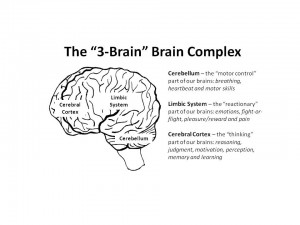Want to Get Through to Teens | Talk to Their Brains. In my decade of research and writing on brain development and the brain disease of addiction, understanding the whole story about puberty and the brain’s evolution [see Image 2 below] gave me the pieces that finally completed the puzzle on how/why teens do the things they do and how/why their peers are so influential and why all of this is so instrumental in the development of substance abuse problems.
If you are a parent, you know what I’m talking about. When your child is around 10 – 11, they still want to be around you, turn to you for comfort and guidance, talk to you about their day and may even still give you big hugs and take your hand. But then puberty arrives, and everyone’s world feels as if it turns upside down. And that’s because it does.
Back in the day – way back in the day, man’s average lifespan was about 25 years. [Sometimes it helps to think of man as but one of the species that make up our world.] The portions of the brain that were most used were the cerebellum – the “motor control” portion of the brain where the neural networks that control breathing, heartbeat, movement are found, and the Limbic System – the “reactionary” portion of the brain where the neural networks that control pleasure/reward, fight-or-flight, pain and emotion are found. It wasn’t until much, much later in man’s existence that the cerebral cortex (includes the prefrontal cortex) – the “thinking” part of the brain, where the neural networks that control reasoning, judgment, motivation, perception, memory and learning are found, evolved into what it is, today. [See Image 1 below.]
So what does all this have to do with puberty and talking to the teen brain in order to reach a teen, let alone have to do with the development of substance abuse problems?
There are three key reasons for puberty, which on average begins around age 12 [see Image 3 below]:
1. to develop the adult-like body and the hormonal changes necessary to make the species want to have sex which then relied on the pleasure/reward pathways in the Limbic System that made the species enjoy sex enough to have it again and thereby reproduce.
2. to take risks (think of the baby bird who one days hops out the nest because something in its species triggers the timing of when it must learn to fly in order to stay safe, find food, reproduce and thereby continue the species)
3. to turn to their peers.
And believe it or not, without these three events, mankind would likely have become extinct. Why? Because when a child reached age 12 back in the day – the age of puberty – mom and dad were likely dead – remember, the average lifespan was 25 years. So there was no mom or dad to run interference. If the species did not gear up, so to speak, in order to want and have sex, take risks and turn to their peers, it would have stayed in the cave, and… well…so much for mankind.
Image 3 below shows a time-lapse study of the brain’s development from age 5 – 20. Notice how the cerebral cortex portion of the brain doesn’t really start maturing until around age 16. It’s now understood its development continues until an average age of 22 for girls and 24 for boys. It is this part of the brain that serves as the brakes on a teen’s risk taking behaviors. It is also this part of the brain that can think through actions and consequences thereof, before taking said action, and better sort through reliable sources vs. unreliable sources. It is this part of the brain that will help a teen become the adult, with the adult-like thinking, judgment, perception, reasoning skills they need to succeed. Unfortunately, it doesn’t develop until years after puberty begins.
This whole brain developmental process – especially that which occurs from ages 12 – early 20s – explains, in part, why teens suddenly seem to take risks, don’t know why they do what they do, turn to their peers for acceptance and guidance, and think mom and dad live on a different planet – withdrawing from them, lashing out at them in anger…. Their brains are wired to do so.
So until the cerebral cortex gets fully up and running with the critically important “thinking” neural networks in place, parents, teachers, coaches – anyone who engages with teens – need to better understand this brain development and learn how to talk to the teen brain in order to reach the teen.
For additional resources, check out:
- The Adolescent Brain: TED Talk by Blakemore
- It’s Time We Tell the Whole Truth About Puberty
- How Parents Can Learn to Tame a Testy Teenager
- A Parent’s Guide to the Teen Brain
This information can also help all concerned better understand How Teens Can Become an Alcoholics Before Age 21.
IMAGES Referenced in Post:

Image 1 – The “3-Brain” Brain Complex. Photo courtesy: Jessica Scott

Image 2: author’s photograph of the Evolution of the Human Brain portion from the Smithsonian Exhibit, Human Evolution, “What Does It Mean to Be Human?

Image 3: Time Lapse Study of Brain Development, ages 12 – 20. [Ages on scan added by author.] Image courtesy: Dr. Paul Thompson
__________________________________



Comments (0)